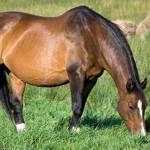Managing Fescue Toxicosis in Broodmares

Many broodmares in the Northern Hemisphere are into, or quickly approaching, the third trimester of pregnancy, a period that is a critical in avoiding problems caused by grazing on tall fescue.
The best and safest policy is to avoid exposure to tall fescue throughout a mare’s pregnancy, but because fescue is widely distributed in pastures in many states, and infection by the endophytic fungus approaches 100% of plants in some areas, this approach is usually not practical for broodmare managers.
Another solution is to remove fescue plants from pastures used by broodmares. This requires a rather expensive and time-consuming process of spraying, planting an alternative crop to smother new growth, repeating the spraying, and finally establishing a stand of a more desirable forage. Because success rates vary widely, farm owners who are able to take a field completely out of the grazing rotation may prefer to turn infected pasture into cropland for a few years. After existing fescue is destroyed, the field can be reseeded with low-endophyte or endophyte-free seed. Strains of tall fescue such as Kenhy, Alta, and Phyter do not contain the toxin-producing fungus. However, these strains are less hardy and require more intensive pasture management. Agricultural extension agents can be contacted for recommended procedures and replacement forage varieties in a particular area.
A compromise that is often followed is to remove broodmares from fescue pastures during the last trimester of pregnancy, switching them onto fescue-free hay or hay cubes. While 60 to 90 days is a recommended avoidance period, eliminating fescue for even a few weeks can make a difference in toxicity problems.
The next step is to contact a veterinarian to see if treatment is advised to counteract toxicity. Drugs such as domperidone and fluphenazine are often successful in reversing the negative effects of the alkaloid, and many treated mares are able to deliver and nurse their foals with few or no complications. Even with treated mares, managers should be sure the foaling is attended and a veterinarian is available. The attendant may need to cut the thickened placenta or help the mare expel a large foal that is several weeks overdue. A supply of colostrum should be available for foals whose dams cannot produce this vital fluid, and milk replacer or nurse mare services may be needed soon after the birth.








